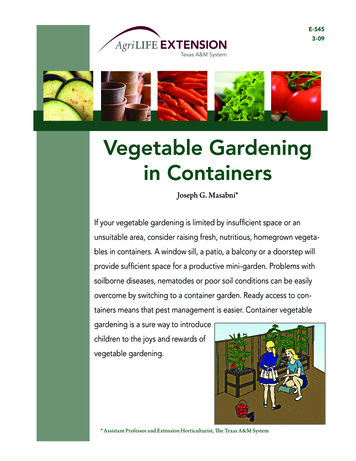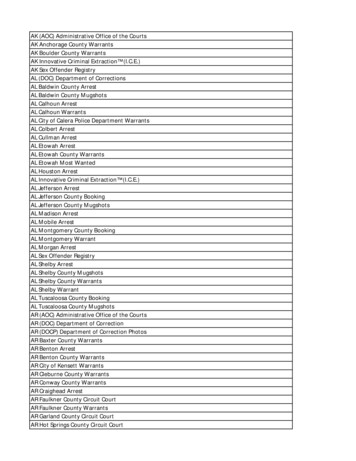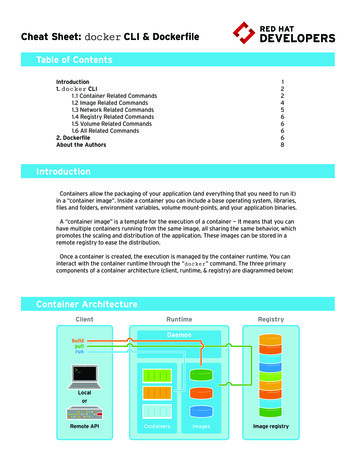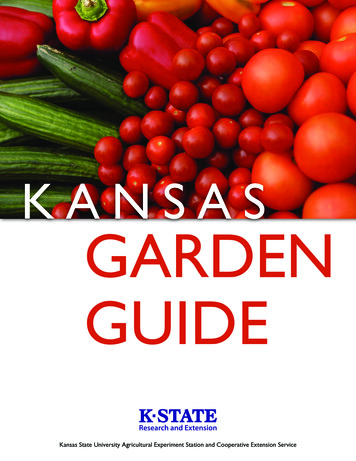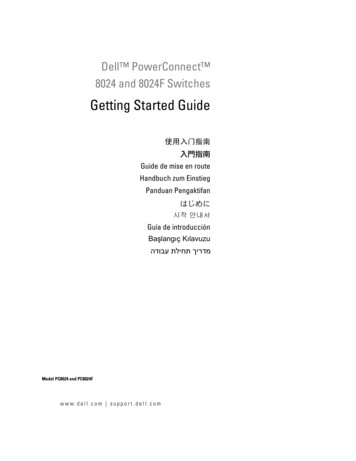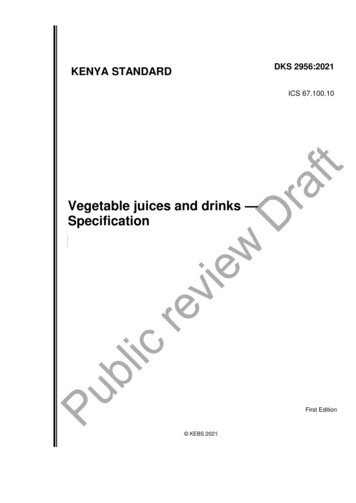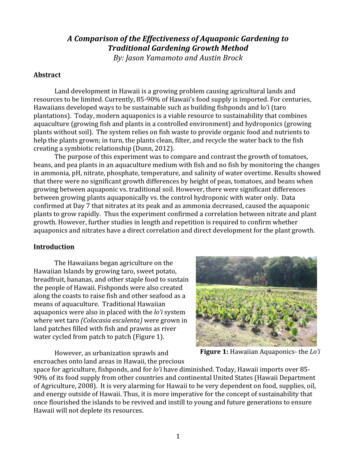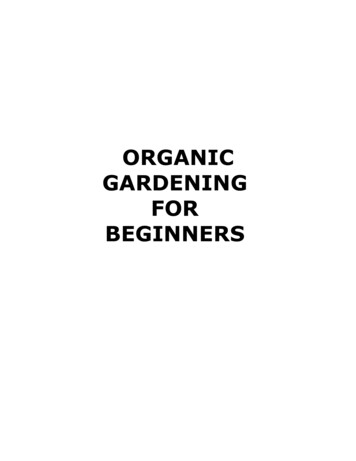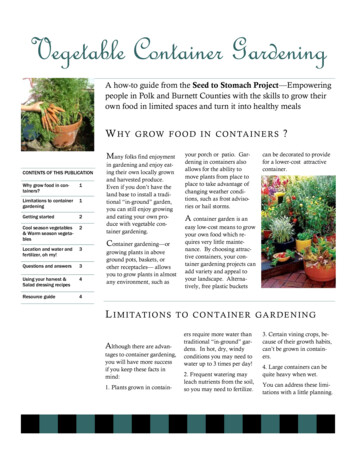
Transcription
Vegetable Container GardeningA how-to guide from the Seed to Stomach Project—Empoweringpeople in Polk and Burnett Counties with the skills to grow theirown food in limited spaces and turn it into healthy mealsW HYG ROW F OO D I N C ONTAI NE RSyour porch or patio. Gardening in containers alsoallows for the ability tomove plants from place toplace to take advantage ofchanging weather conditions, such as frost advisories or hail storms.Many folks find enjoymentCONTENTS OF THIS PUBLICATIONWhy grow food in containers?1Limitations to containergardening1Getting started2Cool season vegetables& Warm season vegetables2Location and water andfertilizer, oh my!3Questions and answers3Using your harvest &Salad dressing recipes4Resource guide4in gardening and enjoy eating their own locally grownand harvested produce.Even if you don’t have theland base to install a traditional “in-ground” garden,you can still enjoy growingand eating your own produce with vegetable container gardening.growing plants in aboveground pots, baskets, orother receptacles— allowsyou to grow plants in almostany environment, such aseasy low-cost means to growyour own food which requires very little maintenance. By choosing attractive containers, your container gardening projects canadd variety and appeal toyour landscape. Alternatively, free plastic bucketsT O C O NTAI NE R G A RDE NI NGAlthough there are advantages to container gardening,you will have more successif you keep these facts inmind:1. Plants grown in contain-can be decorated to providefor a lower-cost attractivecontainer.A container garden is anContainer gardening—orL I M I TAT I O NS?ers require more water thantraditional “in-ground” gardens. In hot, dry, windyconditions you may need towater up to 3 times per day!2. Frequent watering mayleach nutrients from the soil,so you may need to fertilize.3. Certain vining crops, because of their growth habits,can’t be grown in containers.4. Large containers can bequite heavy when wet.You can address these limitations with a little planning.
Page 2Vegetable Container GardeningSupplies you will needContainersDrill or Hammer/NailSoilWaterFertilizersRulerScreen or coffee filter (optional)C OOLGETTINGS TA RTE DThe majority of the items needed for a successful container garden are readily available.Fol-low these simple steps to get started!1.Choose your container. Containers can be as simple as ice cream buckets or as fancy as acedar planting box. Choose the size of your container based on which vegetables you’d liketo plant following the guidelines below, which are based on the depth of the container.2.All containers need drainage holes. Use a drill or a hammer and nail to make 3-5 evenlyspaced holes in the bottom of the container. An optional piece of screen or coffee filter canbe placed in the bottom of the container over the holes to keep soil in the container.3.Fill the container with soil, being careful to leave about an inch of headspace to allow forwater to collect.4.Plant your vegetables. Use the guidelinesbelow to determine what time of the year toplant certain vegetables.5.Maintain your vegetable plants with properwatering and fertilization (see page 3).6.Enjoy your harvest!SE A SO N V E GE TA B L E SW A RMSE A SO N V E GE TA B L E SVegetables that do best when planted in the spring orAs the name implies, warm season vegetables requirefall are called cool season vegetables. Follow the directions on the seed packet for information about plantingspace and depth. Cool season vegetables include:warmer soil temperatures for survival. These vegetablesshould be planted after all danger of frost has passed(generally May 17-23 in Polk and Burnett Counties).Due to our short growing season, eggplant, pepper, andtomato should either be started inside or purchased astransplants (not seeds). When purchasing seeds, look forvarieties described as compact, bush, tiny, dwarf, orpatio which are better suited for container gardening.Beets—minimum 6” container depthBroccoli—12-18” container depthCabbage—12-18” container depthCarrots—minimum 8” container depthCauliflower—12-18” container depthLettuce—minimum 6” container depthMustard greens—minimum 8” container depthParsley—minimum 6” container depthPeas—minimum 8” container depthRadishes—minimum 6” container depthSpinach—minimum 6” container depthBush beans—minimum 6” container depthCucumber—minimum 10” container depthSummer squash—minimum 10” container depthEggplant—minimum 10” container depthPepper—minimum 8” container depthTomato—12-18” container depthTo plant seedlings, remove the transplant from its potby gently pulling near the base of the plant stem.Loosen the soil around the roots and plant the seedlingat its original depth in your container.
Page 3L OC ATI ON AN D WAT ER AN D F ERTIL IZ E R , O H MY !When determining whereVegetable plants requireto place your containerskeep the following information in mind.about 1 inch of water perweek, either through rainfallor watering, to ensure adequate growth.Vegetable crops requireat least 6 hours of directsunlight per day.Check the weather dailyand be sure to moveyour plants to a warmor sheltered location incase of frost, highwinds, or severeweather.Q UES TI O N SThorough, infrequentwatering stimulates rootgrowth better than frequent small watering.Pour until water runsout the bottom of thecontainer.By watering at the baseof the plant, versus onthe leaves, you can helpprevent fungal diseases.If using a soil-less pottingmix, be sure to consider fertilizers since these mixeshave very few nutrients. A10-10-10 (N-P-K) fertilizer issuitable for most vegetables.Check the fertilizer label forspecific application recommendations.Fertilize seedlings witha solution that has beendiluted 50% to avoidburning young roots.Don’t fertilize wiltedplants; water and waitfor them to recover.Organic (non-chemical)fertilizers options areavailable at most gardensupply stores.AN D AN SW ER SQ: The edges of my plantQ: What is powdery mil-Q: Help, the bottom half ofleaves are turning brown.What might be causing this?dew and how do I recognizeit?my plant is turning yellow!A: The build-up of fertilizerA: Powdery mildew is ain the soil medium may beyour culprit. To address thisproblem halt fertilizing andbe sure that each time youwater your container thatwater runs out of the drainage holes.fungal disease that thrives incool damp conditions.Knowing these facts, powdery mildew can be prevented by providing yourcontainer gardens withplenty of sunlight and goodair circulation. Powderymildew can be recognizedby white moldy areas on theleaves. Prune diseasedleaves and dispose of themin the garbage.bottom half of a plant couldbe caused by overwateringor nutrient deficiency. Letthe mix dry out a little or tryusing a fertilizer solution.Q: What might be causingthe leaves of my plant todroop after watering?A: The most likely cause ofthis problem is a lack of oxygen in your soil. Check tomake sure the drainageholes in your container arenot being blocked by soiland if necessary raise yourcontainer off the groundusing boards or bricks.Q: My plants look long andlanky. How can I correctthis problem?A: Try moving your container into an area that receives at least 6 hours ofdirect sun per day.A: The yellowing of theQ: How do I recognizeinsect damage on my container garden plants?A: Most insects cause irregularly shaped holes inleaves or fruit. You can remove insects by hand or usefloating row covers (meshnetting) as a preventativemeasure. If you do usefloating row covers be sureto remove them when plantsflower to ensure pollination.Don’t remove bees and butterflies which provide beneficial pollination services.Did you know?Food stamp (FoodShare/SNAP)benefits can be used to purchasebedding plants.
U S I N G Y OU R H ARV E S T & S ALAD D RE S S I NG R E CI PE SLettuce is an inexpensive, easy crop togrow in a container and makes a greatbase for summer salads. Add otherhome-grown vegetables and try thesetasty dressing recipes for a healthymeal or side dish! Be sure to store allharvested vegetables in the refrigeratorand rinse them before using.Thousand Island Dressing· 1/3 cup plain nonfat yogurt· 2 tablespoons mayonnaise· 2 tablespoons ketchup· 2 teaspoons white vinegarWhisk together all ingredients in a smallbowl until smooth.Buttermilk Ranch Dressing½ cup buttermilk¼ cup reduced-fat mayonnaise½ teaspoon garlic½ teaspoon salt½ teaspoon pepper1/3 cup chopped fresh herbs, such aschives, tarragon, basil, or dill or 2-3 tablespoons dried herbsWhisk buttermilk, mayonnaise, whitewine vinegar, garlic, salt and pepper in asmall bowl until smooth. Stir in herbs.Simple Balsamic Vinaigrette¼ cup balsamic vinegar2 teaspoons brown sugar1 tablespoon chopped garlic½ teaspoon salt½ teaspoon pepper¾ cup olive oilBeat vinegar, sugar, garlic, salt, andpepper in a bowl until sugar and saltdissolves. Next, beat in the oil bydroplets, whisking constantly. Alternatively, place all the ingredients in alidded container and shake to combine.R E S O URC E G UI D ECheck out these local resources in Polk and Burnett Counties.Container vegetable gardening supplies:Abrahamson’s Nursery, Landscaping, & Design, St. Croix Falls—4833040Balsam Lake Pro-Lawn Nursery, Balsam Lake—485-3131Balsam’s Lakeside Greenhouse Nursery & Landscaping—825-2202Bergmann’s Greenhouses, Clayton—948-2921Dragonfly Gardens, Amery—268-7660Grateful Gardens, Amery—268-9293Kent’s Perennials, St. Croix Falls—483-1775Lake Kountry, Inc., Osceola—248-3018North Country Greenhouse, Milltown—553-0619Painted Farm & Gardens, Luck—419-1129Polk County Recycling Center (containers), St. Croix Falls—483-1088Rose Garden Gifts, Floral, & Greenhouse, Frederic—327-4281Sunshine Gardens, Cushing—488-2864Wood River Garden Store, Grantsburg—463-2426Local hardware & grocery storesMore information on vegetable container gardening:UW-Extension Offices:Burnett County (Siren)—349-2151Polk County (Balsam Lake)—485-8600Local libraries, including:Burnett Community Library (Webster)—8667697Polk County Library Federation (BalsamLake)—485-8680Your School District’s Community Education OfficeThis publication was created by members of UW-Extension’s 2009-2010 Polk-Burnett Leadership Academy as a final graduation project. Toobtain a tool kit for hosting a container vegetable gardening class, please contact the Polk County UW-Extension Office, 485-8600.
spaced holes in the bottom of the container. An optional piece of screen or coffee filter can be placed in the bottom of the container over the holes to keep soil in the container. 3. Fill the container with soil, being careful to leave about an inch of headspace to allow for water to collect. 4. Plant your vegetables. Use the guidelines
